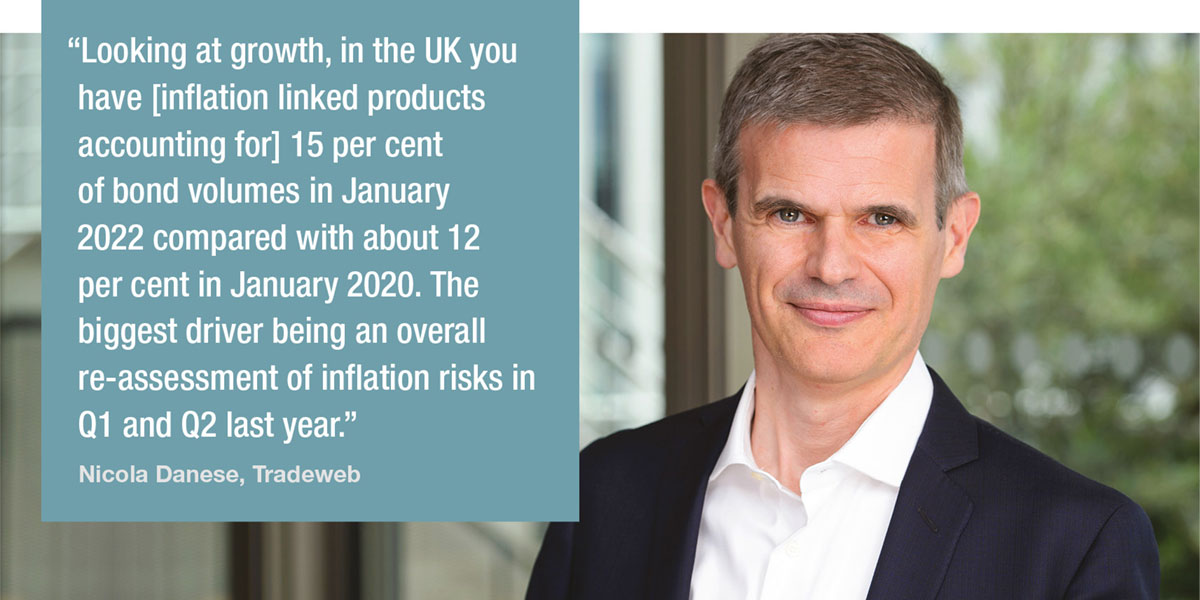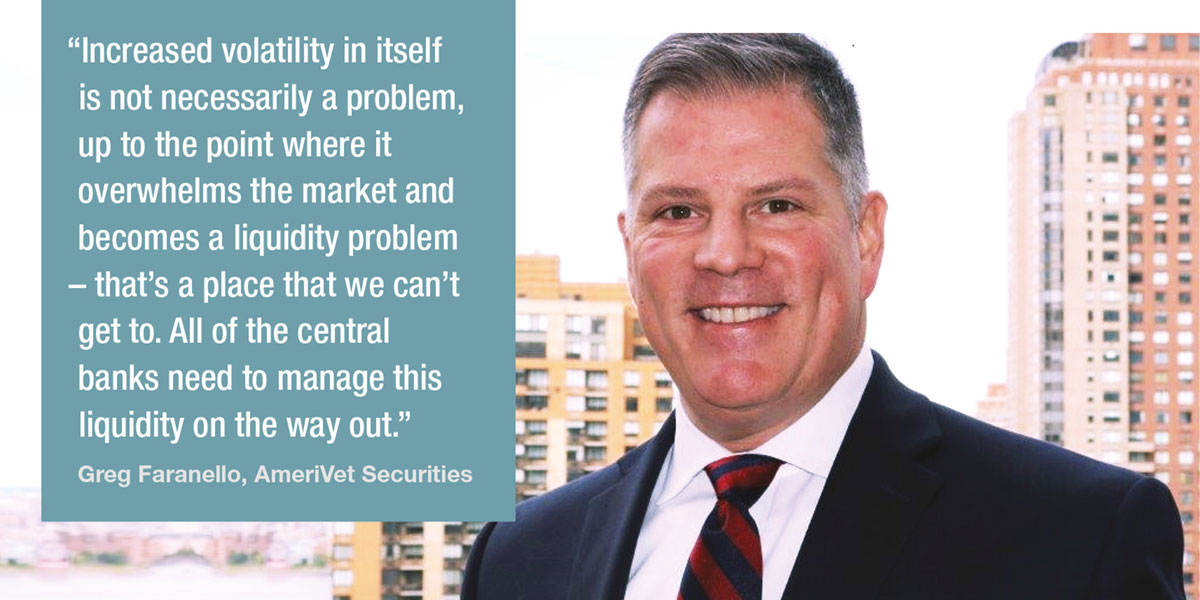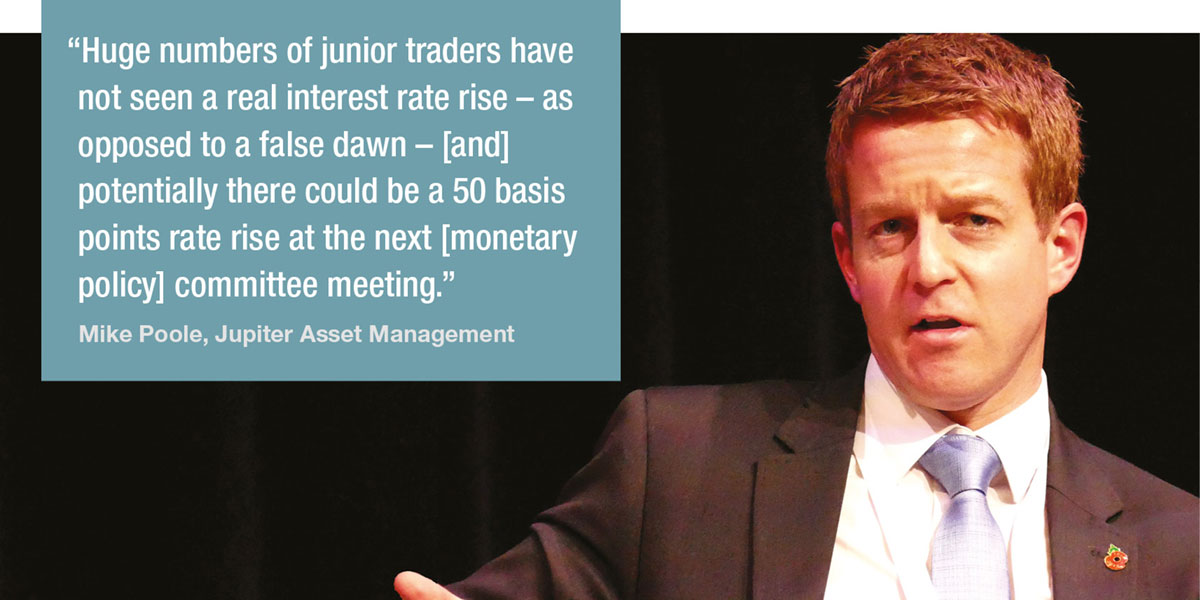Significant rises in inflation have not been seen within the careers of many traders – this is what they need to know.
As inflation increases, measured against the consumer price indexes (CPIs) and commodity prices, central banks will need to raise interest rates to reduce consumer demand as a countermeasure. While this instrument may be a little blunt in a world of war, pandemic and failing trade agreements, it will nevertheless affect markets.
This scenario has not occurred within developed markets for some time, and as a result, many traders will not know what to expect.
“Huge numbers of junior traders have not seen a real interest rate rise – as opposed to a false dawn – [and] potentially there could be a 50 basis points rate rise at the next [monetary policy] committee meeting,” says Mike Poole, senior fixed income trader at Jupiter Asset Management.
Consequently heads of desk and their traders on both the buy and sell side should be mindful of the many different ways in which rising inflation will affect market activity, and by extension their day to day work.

Dan Dewar, head dealer for Henley fixed income at Invesco, says, “Key from a trading point of view is that we have the right structure in place to absorb this, the starting point is having experienced and skilled traders. We then need to provide them with the complete suite of trading tools, pre and post trade data, the right electronic trading capabilities and perhaps most importantly the ability to work with our key counterparty partners for liquidity provision. This provision itself also becomes more of a two way street where the buy side can provide liquidity, especially in less liquid credit markets.”
Added complications are the role of central banks as they also unwind asset purchasing programmes, the ongoing effect of Covid-19 and of course the very unpredictable effects of the conflict between Russia and Ukraine.
More active, more volatile
Rising interest rates can trigger a shift amongst investors towards higher levels of fixed income investments – particularly in the risk-free space while uncertainty is increasing at a macro level – and potentially to look at relative value opportunities.
On the buy-side trading desk that will lead to traders keeping a closer eye on opportunities in fast moving markets.
“With rising inflation, opportunities are likely to occur more frequently, and part of the day job is feeding RV ideas and cross currency ideas to PMs, with us sourcing liquidity on the back of it,” says Poole. “Where markets are in a state of flux there can be a disconnect between macro products and cash bonds, so credit default swaps (CDS) can move disproportionately to the underlying. That is not necessarily reflecting a lack of liquidity in the underlying bonds but there are questions around the level of value in the investment grade cash bond space. PMs are waiting to see what the Bank of England does with the selling down of its Sterling book.”
Being plugged into the investment process is crucial for traders, he notes, with close communication between portfolio managers an absolute necessity even in a remote environment.
“In order to get the look on these opportunities it’s important that traders work very closely and communicate clearly with their fund managers, so we can react quickly when they arise, for first mover advantage,” says Dewar. “We are set up for this and its why our activity correlates highly with an uptick in volatility.”
At a strategic level, there is also a need to consider how effective trading protocols will be in more volatile markets.
“I’m spending more time speaking to market structure heads around how the use of electronic trading and algos might be impacted by rising rates,” says Poole. “We’re also assessing banks’ willingness to show liquidity. Less experienced traders can become a bit defensive about the impact that those trades might have upon returns. It is not just inflation, this is coming as a perfect storm with other things that are going on with the world at a macro level.”

Shifting investments
Fluctuating rates, and greater market uncertainty can affect the investment choices made by portfolio managers, as some increase the use of inflation-linked instruments.
“Looking at growth, in the UK you have [inflation linked products accounting for] 15 per cent of bond volumes in January 2022 compared with about 12 per cent in January 2020,” notes Nicola Danese, head of European fixed income at Tradeweb. “The biggest driver being an overall re-assessment of inflation risks in Q1 and Q2 last year. A proportion of increased usage of inflation-linked instruments prompted the market to converge into the current split. From that point it’s been fairly stable.”
Inflation-linked swaps account for about 5% of Tradeweb’s total swaps delta volumes in GBP with the users of inflation products for the most part being real money investors and pension funds.
“Relevance of liability drive investment (LDI) in the UK market explains higher UK adoption versus Europe,” he continues. “So, basically as a function of their portfolio strategy, typically you are looking at hedging inflation risk, duration risk. The availability of an inflation product is definitely something that is appealing to them. That also explains why we have a much higher proportion of this activity in the UK [than other European markets].”

In the US, Colm Murtagh, head of US institutional rates at Tradeweb, notes that about 10 per cent of Tradeweb’s non-Treasury bill volume is in Treasury inflation protected securities (TIPS).
“There is always a TIPS component to peoples’ portfolios but trading has probably picked up more in the last four months, positioning for CPI for example, and then unwinding it, as people trade the numbers a bit more,” he says. “That is not surprising because there is volatility around them, and there hasn’t been volatility there for a while. I don’t think there is any major difference in participation of client types.”
The firm has also launched US inflation-linked swaps, which Murtagh notes has seen a lot of interest from different participants. “It will be interesting to see how that sort of evolves,” he says.
If a trading desk has the capability to reach across both cash and derivatives markets it makes a real difference to the capacity to represent investment goals in the market.
“The breadth of what we trade is significant, and from swaps to EM to anything with a coupon, we are well set to trade it and navigate liquidity,” says Poole.
Dealer buy-in
Concern around sell-side support for liquidity in such a volatile environment is rising, given the withdrawal of liquidity in 2020 under stressed conditions.

“A sell-side trading desk will need to widen out the cost of liquidity,” says Greg Faranello, head of US rates trading and strategy at AmeriVet Securities. “With regards to bid-offer spreads, for on and off the run securities looking at credit liquidity, we are already seeing credit spreads widen, as a function of increased volatility.”
The way that central banks handle the reduction of asset purchasing and holding will also add liquidity pressure to the market, as banks absorb higher activity across the board.
“The impact of central bank activity on us directly boils down to the provision of liquidity, and that is affected by the cost of balance sheet, the cost of borrowing, the cost of headcount,” notes Poole.
Faranello adds, “Increased volatility in itself is not necessarily a problem, up to the point where it overwhelms the market and becomes a liquidity problem – that’s a place that we can’t get to. All of the central banks need to manage this liquidity on the way out. The wider bid-offer spreads as a function of volatility lends itself to a re-pricing of risk assets which we are seeing.”
As pressure grows on the dealer side of the street, the lack of experience amongst sell-side traders – whose desks have suffered a considerable drop in headcount over the past decade – could also tell in the banks’ ability to support liquidity provision.
“We were speaking about the juniorisation of the sell side back in 2017, and whether or not it impacts liquidity provision,” says Poole. “This point might prove to be the moment where it comes to a head. There may be a need to partner-up with traditional liquidity providers, and a more an old-fashioned approach to getting size done.”
©Markets Media Europe 2022
©Markets Media Europe 2025













